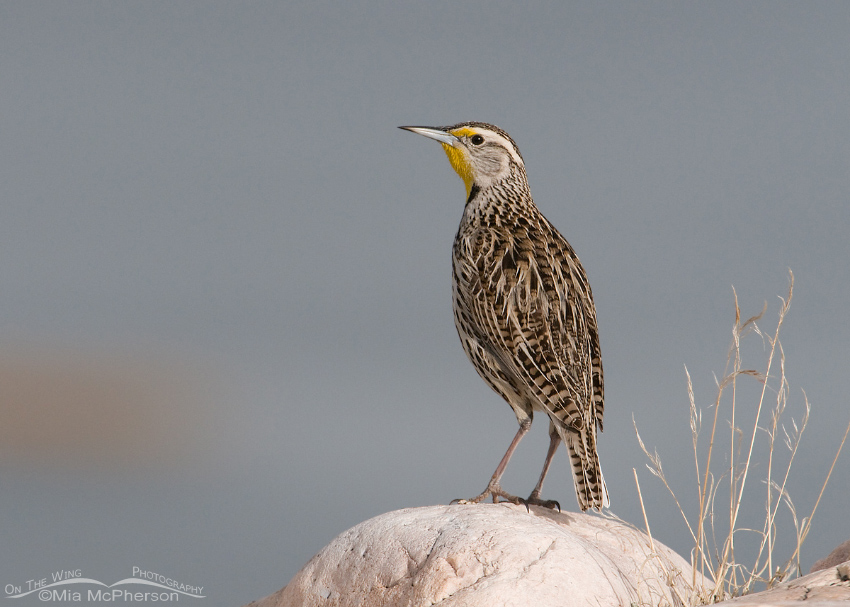 Western Meadowlark on a boulder – Nikon D300, f8, 1/1250, ISO 640, +0.7 EV, Nikkor 200-400mm VR with 1.4x TC at 400mm, natural light
Western Meadowlark on a boulder – Nikon D300, f8, 1/1250, ISO 640, +0.7 EV, Nikkor 200-400mm VR with 1.4x TC at 400mm, natural light
Yesterday I was focused on photographing this Western Meadowlark (Sturnella neglecta) that was perched on a boulder with the Great Salt Lake below it in the background. I had nice light, a lovely setting plus the bird seemed more interested in singing than my presence.
Western Meadowlarks are beautiful songsters and their call is one that makes me think of cool spring mornings and how much I enjoy my early morning journeys into the natural world. They are handsome birds too.
As I focused this bird I noticed some movement at the bottom of my viewfinder, there was a large tan, out of focus blob that appeared to be moving towards the Meadowlark. It was a little confusing at first until I moved the viewfinder away from my eyes a bit and saw a Chukar (Alectoris chukar) moving up towards the same boulder the Meadowlark was singing from.
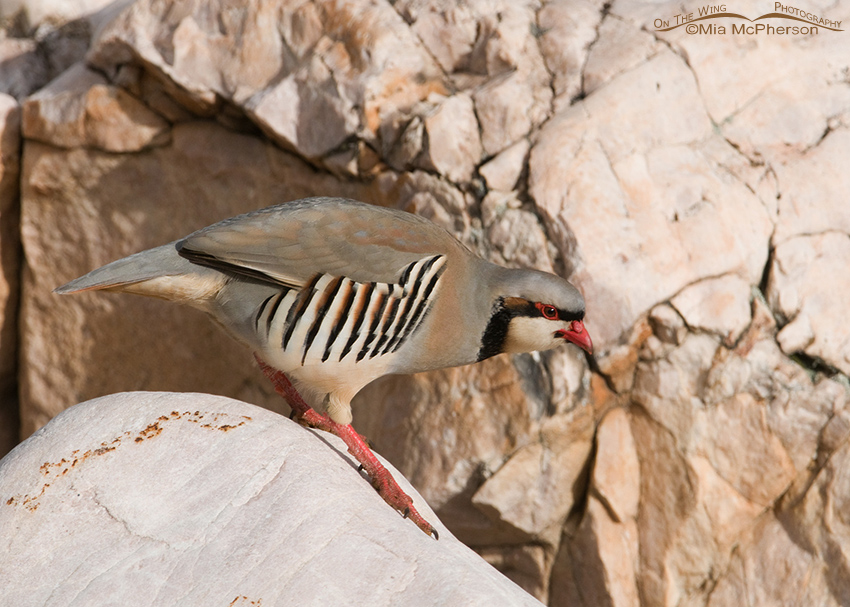 Chukar climbing down a boulder I – Nikon D300, f8, 1/1000, ISO 640, +0.7 EV, Nikkor 200-400mm VR with 1.4x TC at 285mm, natural light
Chukar climbing down a boulder I – Nikon D300, f8, 1/1000, ISO 640, +0.7 EV, Nikkor 200-400mm VR with 1.4x TC at 285mm, natural light
The Chukar was so close that I had to very quickly back up my zoom to fit the whole bird in. It was about the same moment the Chukar noticed my presence and it started moving down the boulder towards the grasses instead of making the climb to the top.
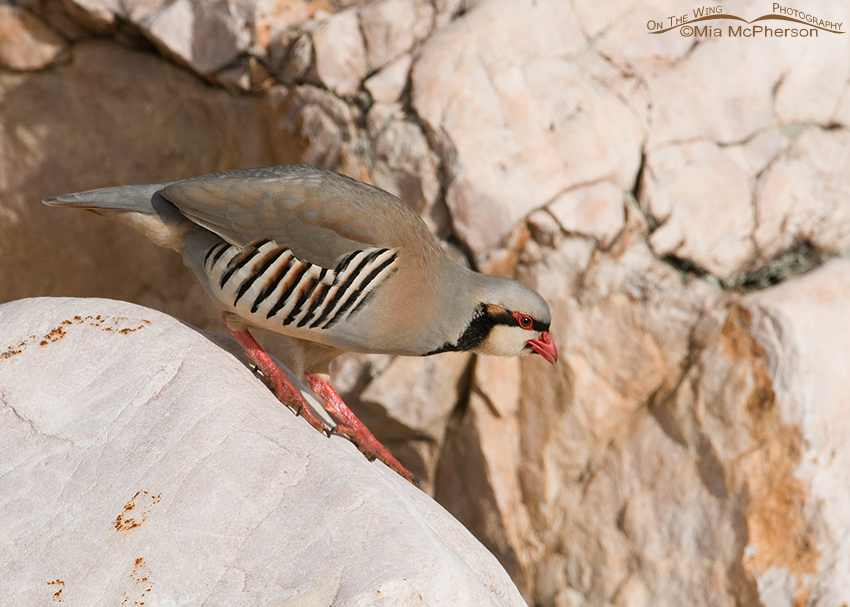 Chukar climbing down a boulder II – Nikon D300, f8, 1/1000, ISO 640, +0.7 EV, Nikkor 200-400mm VR with 1.4x TC at 285mm, natural light
Chukar climbing down a boulder II – Nikon D300, f8, 1/1000, ISO 640, +0.7 EV, Nikkor 200-400mm VR with 1.4x TC at 285mm, natural light
I didn’t have time to change my exposure compensation which had been set for the Meadowlark perched with the blue of the Great Salt Lake behind it and I knew that these images might be slightly over exposed. Fortunately I was able to reduce the exposure in ACR (Adobe Camera Raw) easily.
I could tell I loved the background through my viewfinder, the large boulder was far enough away that I didn’t need to worry about it being in focus but it still showed the lovely colors and textures of the rock.
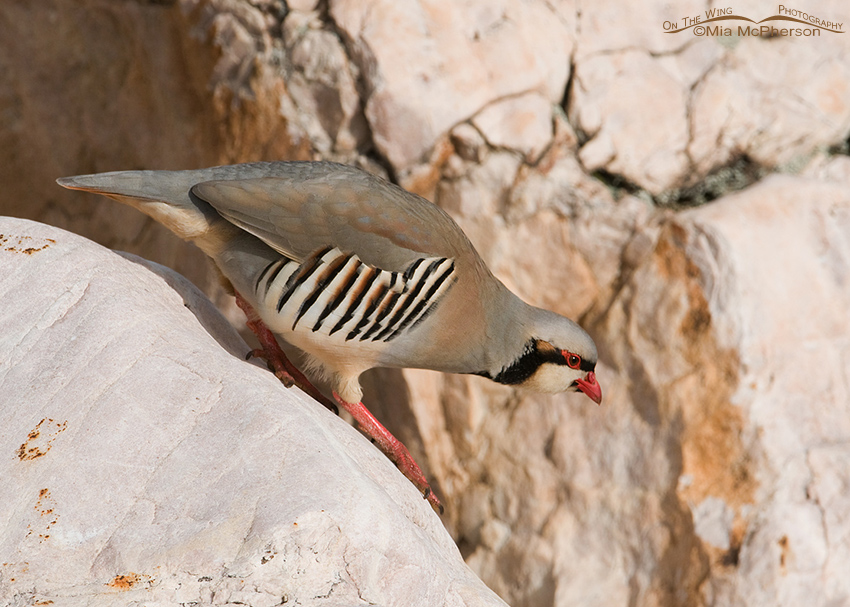 Chukar climbing down a boulder III – Nikon D300, f8, 1/1000, ISO 640, +0.7 EV, Nikkor 200-400mm VR with 1.4x TC at 285mm, natural light
Chukar climbing down a boulder III – Nikon D300, f8, 1/1000, ISO 640, +0.7 EV, Nikkor 200-400mm VR with 1.4x TC at 285mm, natural light
The Chukar didn’t seem to be in a great hurry so I was able to get a series of images as it carefully made its way down the boulder. I liked that I could see the red legs, spurs and dark toenails in this frame.
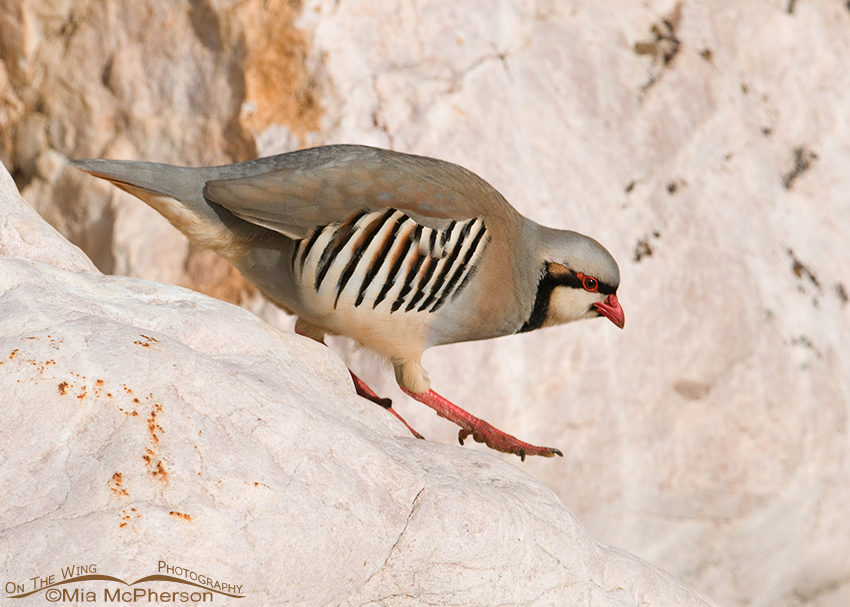 Chukar climbing down a boulder IV – Nikon D300, f8, 1/1000, ISO 640, +0.7 EV, Nikkor 200-400mm VR with 1.4x TC at 285mm, natural light
Chukar climbing down a boulder IV – Nikon D300, f8, 1/1000, ISO 640, +0.7 EV, Nikkor 200-400mm VR with 1.4x TC at 285mm, natural light
As the bird moved closer to the ground I noticed how fresh it plumage was and the beautiful but subtle coloration along the back and wings.
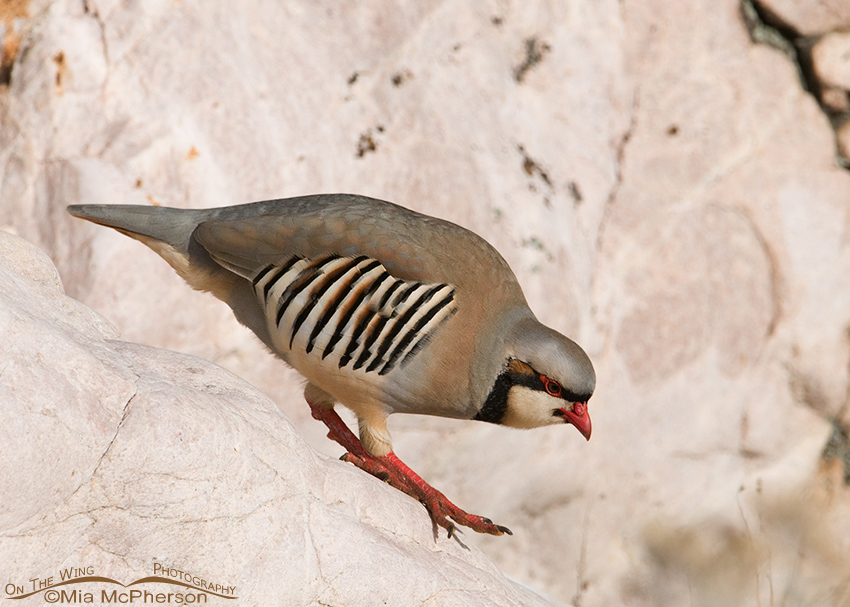 Chukar climbing down a boulder V – Nikon D300, f8, 1/1250, ISO 640, +0.7 EV, Nikkor 200-400mm VR with 1.4x TC at 285mm, natural light
Chukar climbing down a boulder V – Nikon D300, f8, 1/1250, ISO 640, +0.7 EV, Nikkor 200-400mm VR with 1.4x TC at 285mm, natural light
Had I not seen that moving, tan blob beyond my viewfinder I could have easily missed being able to create these Chukar images. Sure, I have hundreds (if not thousands) of Chukar images but I am always looking for different poses, light conditions and settings to photograph my subjects in and this worked out very well.
Lesson Learned… Look beyond the viewfinder at times!
Life is good.
Mia
Click here to see more of my Chukar photos plus facts and information about this species. Click here to see more of my Western Meadowlark photos plus facts and information about this species.


Wow. Great photos! Just the other day I was photographing an Osprey with fish in flight. He was calling an awful lot. When I put down my camera I found out why. He had a Bald Eagle in hot pursuit. Sadly I missed the “exchange.” The eagle stole the fish behind the tree line.
Scott, I’ve missed that same exchange between an Osprey and a Bald Eagle. Frustrating! Thanks for your comment.
The meadowlark is perfect! A nicely executed series of the chukar as well.
Julie, thanks. Nature is amazing.
In Utah, you have the fortune of avoiding the problems of identifying meadowlarks, as the Western is the only ‘Sturnella’ where you are. Not only is the song impressive, it is also important for identification.
I am very fortunate to avoid the issues of identifying that the Meadowlarks I see are Westerns and their song is rather lovely and quite different from the Easterns. Thanks for commenting Mathew.
Great shots color and sharpness spot on.
Thank you Earl, Chukars make excellent subjects and the boulder behind the bird was great.
Excellent series of photos! Great to see the Chukar in action! The boulder makes a beautiful background. The Meadowlark is stunning as well!
Thanks so much for your kind comment Tammy!
Very beautiful, glad you caught it in time! What a treat to have two lovely birds like that so close!
Thanks Laurence, I was glad I caught the Chukar in time too.
These are stunning images, Mia! Your outstanding photographs show off the lovely Chukar plumage beautifully. A very special treat to have such a sighting.
Julie, I felt it was a treat to have this setting for these images too. Utah boulders Rock!
Very nice series on these gorgeous birds Mia- love the fresh plumage and the iridescent coloring of the wings.
Thank you Chuck, you need to visit us at this time of the year, you might even get a chance to photograph the males going at each other over their hens.
Good for you! The Chuckar is fabulous. I have never seen one. But the Meadowlark is a common visitor and like you said a they do have a beautiful song.
Thank you Sheila.
Love the Chukar images and the meadowlark too. Nice photographer flexibility in this set!
Linda, thank you. I was very pleased with the Chukar images because of the setting, the same with the Meadowlark.
I love these images. The boulder is beautiful surrounding the Chukar. I wished I could see one of these birds in real life. That first image of the Meadowlark is beautiful. Carol
Carol, if you ever get to Utah Antelope Island is always wonderful for seeing Chukars in the wild. Thank you very much for your comments on my images. I love that boulder in the background too.